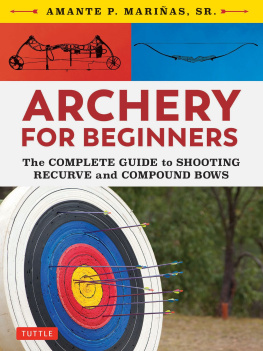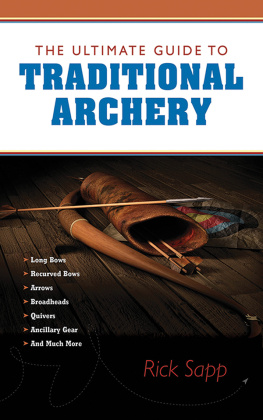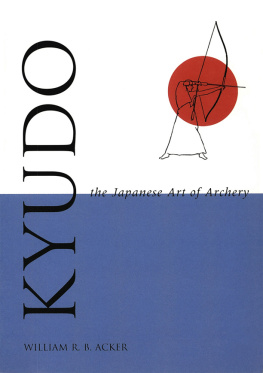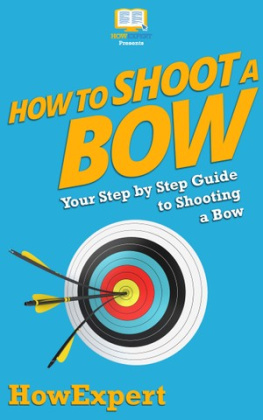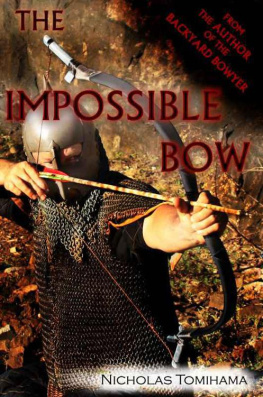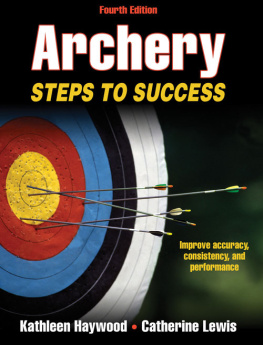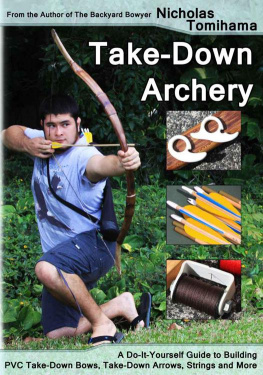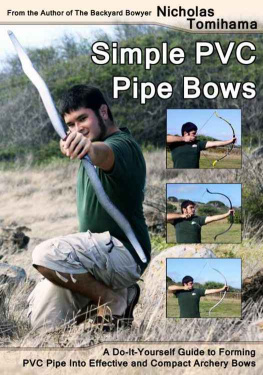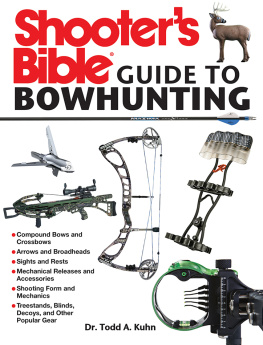ARCHERY
FOR BEGINNERS
ARCHERY
FOR BEGINNERS
The COMPLETE GUIDE to SHOOTING RECURVE and COMPOUND BOWS

Amante P. Marias, Sr.

Please note that the publisher and author of this instructional book are NOT RESPONSIBLE in any manner whatsoever for any injury that may result from practicing the techniques and/or following the instructions given within. Since the physical activities described herein may be too strenuous in nature for some readers, it is also essential that a physician be consulted prior to training.
Published by Tuttle Publishing, an imprint of Periplus Editions (HK) Ltd.
www.tuttlepublishing.com
Copyright 2019 Amante P. Marias, Sr.
All rights reserved. No part of this publication may be reproduced or utilized in any form or by any means, electronic or mechanical, including photocopying, recording, or by any information storage and retrieval system, without prior written permission from the publisher.
Library of Congress Control Number: 2018965819
ISBN 978-1-4629-2075-4 (Ebook)
DISTRIBUTED BY
North America, Latin America & Europe
Tuttle Publishing
364 Innovation Drive
North Clarendon, VT 05759-9436 U.S.A.
Tel: 1 (802) 773-8930
Fax: 1 (802) 773-6993
www.tuttlepublishing.com
Japan
Tuttle Publishing
Yaekari Building, 3rd Floor
5-4-12 Osaki, Shinagawa-ku
Tokyo 141 0032
Tel: (81) 3 5437-0171
Fax: (81) 3 5437-0755
www.tuttle.co.jp
Asia Pacific
Berkeley Books Pte Ltd
3 Kallang Sector #04-01
Singapore 349278
Tel: (65) 6741 2178
Fax: (65) 6741 2179
www.periplus.com
23 22 21 20 19
10 9 8 7 6 5 4 3 2 1
Printed in Hong Kong1901EP
TUTTLE PUBLISHING is a registered trademark of Tuttle Publishing, a division of Periplus Editions (HK) Ltd.
ABOUT TUTTLE
Books to Span the East and West
Our core mission at Tuttle Publishing is to create books which bring people together one page at a time. Tuttle was founded in 1832 in the small New England town of Rutland, Vermont (USA). Our fundamental values remain as strong today as they were thento publish best-in-class books informing the English-speaking world about the countries and peoples of Asia. The world has become a smaller place today and Asias economic, cultural and political influence has expanded, yet the need for meaningful dialogue and information about this diverse region has never been greater. Since 1948, Tuttle has been a leader in publishing books on the cultures, arts, cuisines, languages and literatures of Asia. Our authors and photographers have won numerous awards and Tuttle has published thousands of books on subjects ranging from martial arts to paper crafts. We welcome you to explore the wealth of information available on Asia at www.tuttlepublishing.com.
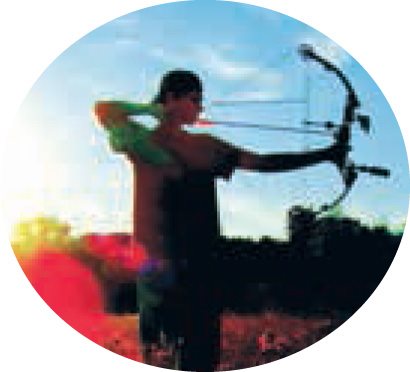
To my grandchildren Nadia & Amante III and to my beloved wife Cherry

ACKNOWLEDGMENTS
Thanks to my students, Stefan Dodson for the compound bow, Christopher Squires for the recurve bow, Stan Hubbard for the 550 paracord and freshly cut wood from his backyard, Ueli Laeng for the work he did on the rattan pole and on the anahaw, and to Thoraya Zedan for posing for the photographs, speed detector, and computer help.
Thanks to my valued family friends Glen and Babet Sullivan for the bamboo, to my son Amante II and daughter-in-law TaShana for the recurve bow, and to my wife Cherry who always had given me all the time I needed to put my thoughts into written words.
Preface
I had plenty of practice with the slingshot having lived my childhood in a small village, Pambuan, in Central Luzon in the Philippines. There, if I wanted fruit, I had to climb a tree and if I wanted a snackmainly birdsI had to catch them myself, really, shoot it down.
One time, I was able to shoot down a bird in full flight. Try as I might, I was never able to repeat the feat. It was a lucky shot. I was not the best shot in the village. One of my friends was. When he aimed at a bird, it was as good as done.
Three other activities that occupied our time were throwing stones by the river, throwing sharpened sticks (bagakays) at banana stalks, and shooting bamboo blowguns (short sumpits). In my childhood, we considered these as games. To my forebears, it was training for survival.
I now live half a world away in Fredericksburg, Virginia. I still shoot a slingshot (homemade), shoot blowguns (made of aluminum), and throw not wood but knives (steel). There is one obvious similarity among all these activities: a projectile is propelled toward a target by the release of stored energy
in the bent throwing arm and the twist of the body in throwing a knife
in the compressed air held in the lungs in shooting the blowgun, and
in the stretched rubber bands in using a slingshot
I have published books on the blowgun (Blowgun Techniques) and on knife throwing (The Art of Throwing). I have written an unpublished manuscript on the conceptual physics of the slingshot, I said to myself, Why not write a book on shooting the bow?
I would have taken up archery much earlier in life but some things got in the way, including my writing on other topics. I started shooting the bow 12 years ago and to date I have retrieved about 200,000 arrows from my targets, which is really not that much considering I have thrown knives about 1,500,000 times and shot the blowgun about 800,000 times.
My experience in my daily bow shoots started crowding other things in my mind. The load on my mind got heavier than the proverbial ton-of-bricks. So one night, I decided to lighten it a bit. I started writing this book.
I shoot the bow daily, aiming to get to the 300,000-shot mark. Normally I shoot the bow early in the morning but sometimes I have to wait for the early morning robins to fly away after they had their fill of worms. I leave them alone. They have to eat and feed their young.
I merely want to hone my martial arts skills and have fun.
INTRODUCTION
Recreational archery is one of the most popular pastimes in the country and for good reason. While there is a learning curve involved, as well as equipment you must purchase, the benefits to taking on archery are great.
So, what do you need to succeed in archery? Obviously, a healthy set of hands (and fingers) is critical if one is to become an archer. Safety is a very important part of succeeding in archery. From the earliest days, injuries and wounds afflicted archers. Today, archery is a sport and a pastime but in the past archery was a matter of life and death.
In the battle of Shrewsbury in 1403, a sixteen year old prince was hit by an arrow on the left side of his nose. He survived the wound but was left with permanent scars. Hence, he knew that archers were very much feared and hated by the enemy. Twelve years later, October 25, 1415, that prince, as King Henry V, led his army at the Battle of Agincourt. Just before the battle, in a speech to encourage his men he said, The French had boasted that they would cut two fingers of the right hand of all the archers that should be taken prisoners. The French lost the battle. Thus originated the Agincourt salute where the English and Welsh archers demonstrated that they didnt lose their bow fingers by flashing the two-finger V sign. Today, the stakes are not so high but the importance of avoiding injury is just as great.
Next page
